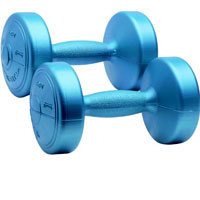Stanford researchers explore muscle cell rejuvenation
Last week, Stanford researchers published a paper called "Rejuvenation of the muscle stem cell population restores strength to injured aged muscles" in Nature Medicine. It's an interesting study, showing that the loss of strength and muscle mass that accompanies aging is partly the result of muscle stem cells that stop working properly – and, more intriguingly, that it may be possible to "rejuvenate" those stem cells in targeted areas, for example around the hip followed hip replacement surgery.
Neat stuff, but that's not why a reader e-mailed me about it. Instead, a quote about the general problem of age-related muscle loss from one of the researchers in a press release accompanying the study caught his eye:
"You lose fifteen percent of muscle mass every single year after the age of 75, a trend that is irreversible," cites Gilbert, Assistant Professor at the Institute of Biomaterials & Biomedical Engineering (IBBME) and the Donnelly Centre for Cellular & Biomolecular Research (CCBR).
There are two surprising claims in there: that you lose 15% of your muscle mass per year, and that this is irreversible. True or false?
I think the first fact is just typo (or speak-o). From what I can tell, the usual estimate is that start losing 15% of your muscle mass per decade at that point. Here's a quote from a review paper on sarcopenia (age-related muscle loss) published last year:
A progressive loss of muscle mass occurs from approximately 40 years of age. This loss has been estimated at about 8% per decade until the age of 70 years, after which the loss increases to 15% per decade.
But is it irreversible? Well, it's always difficult to defend absolute statements – there are undoubtedly cases where people over the age of 75 are able to add muscle mass. (Example: here's a recent study where mobility-limited subjects between 70 and 85 managed to add an average of 1.3% to their lean mass after six months of high-intensity resistance training and protein supplementation.) Still, there's no doubt that the body undergoes a number of progressive and fundamental changes that make it harder and harder for anabolism to outweigh catabolism; the stem cell malfunctions described in the new Stanford paper are just one of many such changes. As this article explains:
Other factors, such as age-related changes in circulating levels of muscle anabolic hormones and growth factors, must also be considered as contributing mechanisms underlying the sarcopenic phenotype. Factors such as general health status and nutrition in conjunction with appropriate physical activity can help attenuate the rate of physical decline, preserve functional independence and maintain quality of life. Although it is generally accepted that age-related changes in skeletal muscle structure and function are inevitable, whether these deleterious effects on skeletal muscle can be stopped or reversed is debatable.
So from a practical perspective, for most people, it's probably fair to say that whatever muscle you lose once you're in your 70s, you're highly unlikely to get it back. For that matter, the same is true for the 8% per decade that you start losing after the age of 40. Not that it's impossible to put on muscle after 40 – it's just that the deck is increasingly stacked against you. This was one of the biggest surprises for me when I was researching my book, and it really spurred me to reevaluate my exercise regimen. I'm an endurance junkie, but as a guy in my late 30s, I now realize that I have a finite window to ensure that I have enough muscle mass to last me through what I hope will be a long and crotchety old age.
Source:
www.runnersworld.com







